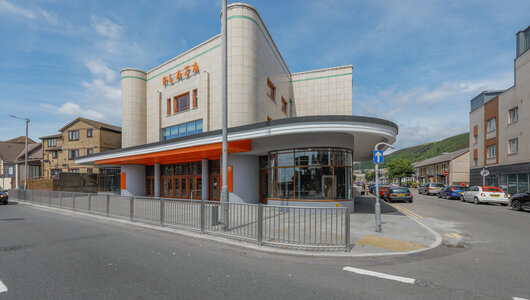Conservation & Regeneration Award 2023
The Plaza Redevelopment – Port Talbot – BAM Construction, Neath Port Talbot CBC, GWP Architecture, Hydrock, Asbri Planning, Vale CRW
Category sponsored by 
What was once at the centre of the community of Port Talbot, the Plaza Cinema began construction in 1939. Due to the outbreak of the second world war and a shortage of materials, the cinema didn’t open until the late 1940s and was completed in 1950 with the addition of the Faience tile façade. Throughout its life the Plaza was a cinema, theatre, bingo hall and even hosted Welsh professional wrestling.
The Plaza Cinema closed in 1983, becoming a bingo hall for 2 years before reopening in 1985 as a cinema, then a multi-screen cinema in 1989. It remained in this configuration until January 1999 when the Plaza closed its doors. Already starting to fall into a state of disrepair the 1st iteration of the Plaza came to an end, having limped its way to its 60th anniversary.
In August of 1999 the Plaza was given Grade II listed status as “a very rare example in Wales of a building type which expresses the distinctive architectural vocabulary of 1930s cinema architecture”; one of only six cinemas from the Art Deco period of the 1920s and 1930s which have survived throughout Wales, and childhood haunt of Richard Burton, Anthony Hopkins and Michael Sheen. The Plaza Cinema comprised an iconic Faience-tiled and curved glass Art Deco frontage and a more utilitarian roughcast rendered rear, which were both in extremely poor condition.
For the repair and restoration of the frontage multiple heritage specialist conservators were needed. They restored original feature hardwood doors and replicated the shopfront hardwood window frames, restored damaged and corroded Crittall windows, repaired damaged Faience tiling and Terrazzo flooring, and repaired the reconstituted stone plinth. Specialists also manufactured the thick, large, curved glazed shopfront units and metalworkers replicated the steel downstand canopy and iconic ‘PLAZA’ sign.
Linking the frontage and rear was exceptionally difficult, as the central section comprised the original ground floor and part of the first floor, with a new, oversailing, second floor and roof.
The philosophy of both the Council and YMCA towards a sustainability strategy was underpinned through building re-use, high levels of insulation and natural daylighting, heat recovery, photovoltaics, a ‘green’ roof, sustainable drainage systems.
